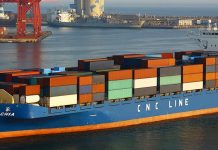ESPO presented yesterday (Oct. 17) its annual Environmental Report for 2018 at the GreenPort Congress in Valencia. The ESPO Environmental Report includes environmental performance benchmark indicators as well as the Top 10 Environmental Priorities of the European ports for 2018.
Air quality has remained the top priority of the European ports since 2013. The increased interest in the relationship with local community in position 4 of the list is relevant as air quality has been increasingly a concern for citizens of port cities and urban areas. Climate change is becoming of high relevance for European ports. It made it in the Top 10 for the first time in 2017 and climbed to the position 7 in 2018. Almost eight out of ten European ports take into consideration climate change when they develop new infrastructure projects. Furthermore, 59% of ports strengthen the climate resilience of existing infrastructure and 41% of them have already dealt with operational challenges due to climate change. Marine litter-related priorities went also higher in the Top 10 list compared to last year. Waste was the most monitored issue increased by 17% since 2013. This indicates the readiness of ports to contribute to addressing the issue of marine litter.
73% of the ports are certified under an environmental standard (ISO, EMAS, PERS) increased by 19% since 2013, while 68% of them make their environmental report publicly available. On the development of alternative fuels infrastructure, the report finds that 24% of the ports provides high voltage shore-side electricity for ships at berth and 30% of them with LNG refueling points, while another 24% is currently developing LNG infrastructure projects.
“ESPO publishes its annual ‘check-up’ for the European ports, the benchmark indicators, which become a point of reference for the environmental performance of the sector. The report will be a good source of information for all interested stakeholders, local communities, civil society, researchers and industry.
On alternative fuels infrastructure, we see increased investments on the port side but we believe that related port investments would accelerate if the remaining barriers for uptake are addressed. For instance, energy taxation on electricity has been a significant barrier for the uptake of shore-side electricity for ships, being often the reason why it does not make a strong business case.
We are aiming to include more indicators in the report of next year. We also encourage all ports to join EcoPorts in order to improve their environmental performance, better communicate their environmental policy and broaden the sample of ports that feed into the annual benchmark performance of the sector.” says ESPO’s Secretary General, Isabelle Ryckbost.





